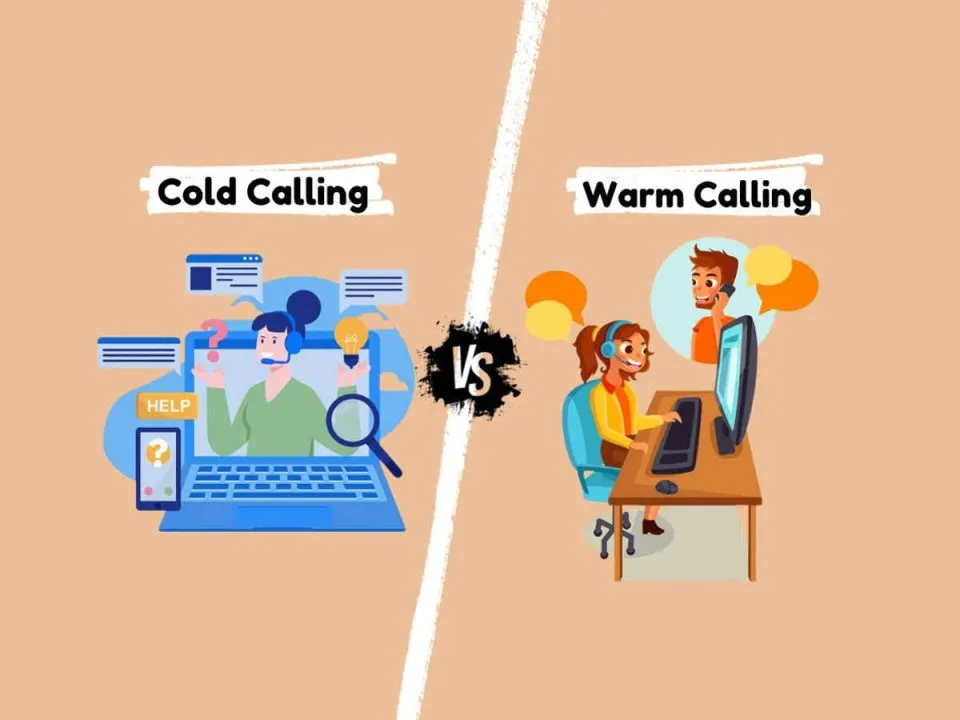Cold calling is a direct sales technique where a salesperson contacts potential customers without prior interaction to introduce a product or service. It’s often seen as challenging, but when done right, it can lead to meaningful conversations and new opportunities.
Studies show that about 78% of decision-makers have taken an appointment or attended an event after receiving a cold call. By mastering cold calling techniques and preparing for each call, you can improve your success rate significantly.
This article will guide you through key tips and strategies to help you make successful cold calls confidently.
What is a Cold Call?

A cold call is an unsolicited phone call made by a salesperson to potential customers to introduce a product or service without prior contact or expressed interest. It’s part of the sales process aimed at generating leads and initiating conversations.
Cold callers often focus on addressing pain points, asking questions to understand prospects’ needs, and presenting a solution. With proper preparation, such as using scripts and targeting decision-makers, cold calling becomes an effective sales strategy.
The goal is to schedule follow-ups, build relationships, and guide prospects toward the next stage in the process, ultimately increasing the success rate of calls.
How Do You Make an Initial Cold Call?

Making an initial cold call starts with preparation. Research the company, organization, and the person you’re calling to understand their needs. Use a clear script to guide your conversation while remaining flexible and natural.
Start with a strong introduction and mention how your product or service can address their pain points. Focus on asking questions that show genuine interest and help you gather key points about their business. Avoid sounding like a sales pitch; instead, engage in a meaningful conversation.
If you face objections, handle them calmly and provide solutions. Ensure the right person is on the call to avoid wasting effort. Keep the tone professional and aim to schedule a meeting or follow-up.
Persistence is key, but know when to end the call gracefully. Every successful cold call is an opportunity to build relationships and move the conversation to the next stage.
When is the Best Time to Make a Cold Call?

Whatever your feelings are about cold calling, the fact is that it is an unavoidable part of customer acquisition, especially for a new company.
Even though cold calling is statistically less successful than other sales tactics, even the most skilled cold callers only have a 2% success rate, there are ways to improve your team's cold calling techniques.
The best time to make a cold call:
If you're going to cold call, you should do so strategically. According to a recent study, the best days to call prospects are Wednesdays and Thursdays.
When you think about it, it makes sense: The start of the week is often chaotic as individuals settle in and deal with already scheduled meetings, and no one wants to deal with work on Fridays.
Getting people in the middle of the week implies you're getting them at their most relaxed and friendly.
Let's take a look at the time now. Calling prospects for a whole 9–5 shift is ineffective. You're unlikely to have much luck if you phone during lunch or during peak afternoon meeting times.

Instead, call between 10 a.m. and 11 a.m., and 4 p.m. and 5 p.m. Those are the "golden hours." People are settling in from their commutes and preparing their lunchtime wrap-ups between 10 and 11 a.m.
They're getting ready to depart at 4–5, and they're probably avoiding job chores, so they're eager to take a phone call.
So, what do you do with the rest of your time? Because not all of your clients and prospects respond to cold calls, adjust your sales team's focus.
When you allocate days and/or hours for cold calls, your sales staff is relieved of the monotony of rejection and is able to focus on developing relationships with warmer prospects.
10 Key Cold Calling Techniques to Elevate Your Sales Game

1. Overcome the Fear of Rejection
Rejection is common in cold calls, but it’s not personal. Each "no" is a step closer to the next "yes."
Build Resilience:
- Reframe rejection as feedback to refine your approach.
- Practice objection handling to stay composed.
- Focus on long-term results, not individual outcomes.
- Celebrate small wins to maintain motivation.
2. Know When to Cut Your Losses
Spending too much time on unqualified leads can hurt productivity. Recognize when to move on.
Identify Red Flags:
- Assess the prospect’s tone and interest level early.
- Politely end calls with prospects who clearly aren’t a fit.
- Prioritize high-potential leads in your sales pipeline.
- Use follow-ups strategically for prospects needing more time.
3. Stick to Your Script, But Stay Flexible
A script is your roadmap, but conversations require adaptability.
Balance Structure with Spontaneity:
- Use scripts to guide key points, not dictate the entire call.
- Incorporate natural pauses and adjust based on the prospect’s tone.
- Avoid rigidly sticking to the script if the conversation shifts.
- Practice different approaches to stay confident in unexpected scenarios.
4. Research Your Prospects Thoroughly
Cold calls are more effective when personalized. Research helps you craft a relevant pitch.
Gather Useful Insights:
- Study public records or the company’s website for background details.
- Look for pain points the prospect might face.
- Identify decision-makers to avoid unnecessary gatekeeping.
- Use tools like LinkedIn to find common connections or interests.
5. Use a Strong Opening Line
The first few seconds determine whether the prospect stays on the line.
Craft a Powerful Introduction:
- Start by addressing the prospect by name.
- Mention a shared interest or reference relevant industry points.
- Clearly state why you’re calling and how it benefits them.
- Avoid overly generic or salesy introductions.
6. Ask the Right Questions
Good questions uncover needs and show you’re interested in helping, not just selling.
Engage with Purpose:
- Begin with broad, open-ended questions to spark discussion.
- Drill down with specific questions to uncover pain points.
- Clarify responses to ensure you understand their challenges.
- Keep questions relevant and avoid overwhelming the prospect.
7. Focus on Listening More Than Talking
Cold calls should feel like conversations, not monologues. Listening helps you tailor your pitch.
Be an Active Listener:
- Take brief notes to capture important points.
- Use verbal nods or small acknowledgments to show engagement.
- Avoid interrupting; wait for natural pauses to respond.
- Reflect on what they share to build trust and rapport.
8. Maintain a Positive and Professional Tone
Your tone influences how the prospect perceives you. Confidence and warmth matter.
Project Confidence:
- Smile while speaking to sound approachable.
- Keep your energy consistent, even if the call isn’t going as planned.
- Use clear, professional language, avoiding jargon.
- Stay composed and polite, even with difficult prospects.
9. Practice and Refine Regularly
Skill-building is essential to improve your cold calling effectiveness over time.
Hone Your Skills:
- Role-play calls with colleagues or managers for feedback.
- Record your calls (with consent) to identify areas of improvement.
- Test different approaches to find what works best.
- Dedicate time weekly to refining specific skills, like objection handling.
10. Track and Analyze Your Results
Data-driven decisions improve your strategy and help you see what’s working.
Leverage Analytics:
- Document call outcomes in your CRM system for easy tracking.
- Analyze trends, such as success rates or common objections.
- Compare performance across different scripts or techniques.
- Use insights to adjust your approach and optimize future calls.
What are the Best Tips for Cold Calling?

1. Set a Clear Goal
Every cold call should have a defined purpose, whether it's setting an appointment, introducing your product, or gathering information.
How to Set Your Goal:
- Identify the primary objective before making the call.
- Consider secondary goals, such as identifying decision-makers or potential needs.
- Avoid overloading the call with too many objectives; keep it simple.
- Use measurable outcomes to track your success, such as one appointment per day.
2. Personalize Your Approach
Cold calling isn’t one-size-fits-all. Tailoring your conversation to each prospect increases engagement.
Ways to Personalize Your Call:
- Use public records to gather basic information about the prospect or their company.
- Reference any prior interaction or interest shown in your product.
- Adjust your tone and language to match the prospect’s communication style.
- Avoid generic pitches; focus on the prospect’s specific pain points.
3. Use the Prospect’s Name
A personal touch, such as using the prospect’s name, makes the call feel less transactional and more engaging.
Why Names Matter:
- Addressing the prospect by name builds rapport and shows attentiveness.
- Avoid overusing their name, which may come across as insincere.
- Confirm the pronunciation before the call to avoid awkward moments.
4. Keep Introductions Short
Long-winded introductions can lose a prospect’s attention. Be concise and get to the point quickly.
Crafting a Concise Introduction:
- Mention who you are, the company you represent, and the purpose of your call.
- Avoid unnecessary details; prospects value clarity.
- Use simple language that prospects can quickly understand.
- Keep introductions under 15 seconds.
5. Leverage Social Proof
Highlighting your credibility through social proof can make prospects more receptive.
How to Use Social Proof:
- Reference well-known clients or industries your company has worked with.
- Share brief success stories that align with the prospect’s needs.
- Mention any recognition or awards your company has received.
- Avoid exaggeration; keep examples relatable and authentic.
6. Handle Objections Well
Handling objections calmly shows professionalism and builds trust.
Steps to Handle Objections:
- Listen to the objection fully before responding.
- Use empathetic language to acknowledge their concern.
- Offer a solution or clarification that addresses the objection directly.
- Avoid arguing or pressuring the prospect; aim for a constructive dialogue.
7. End with a Call-to-Action
A strong call-to-action keeps the conversation moving toward your goal.
Examples of Effective CTAs:
- “Can we schedule a quick meeting to discuss this further?”
- “Would you be open to exploring how this could help your team?”
- “I’ll send over some details. Can I follow up with you next week?”
- Keep CTAs specific and action-oriented to make it easier for prospects to respond.
8. Take Notes During Calls
Taking notes helps you stay organized and remember important details for follow-ups.
How to Take Effective Notes:
- Jot down key points such as objections, questions, or potential needs.
- Use shorthand to avoid disrupting the flow of the conversation.
- Review your notes immediately after the call to add any missing details.
- Organize notes in your CRM or a dedicated tracking system.
9. Maintain High Energy
Your energy affects how prospects perceive you. Staying positive and enthusiastic helps keep their interest.
Ways to Maintain Energy:
- Stand up while calling; it naturally adds energy to your tone.
- Smile while talking to sound more approachable.
- Take breaks between calls to stay fresh.
- Avoid letting past rejections affect your tone during the next call.
10. Follow Up Quickly
Cold calling doesn’t end when the call does. Timely follow-ups show professionalism and increase conversion chances.
Best Practices for Follow-Ups:
- Send an email or call back within 24-48 hours of the initial call.
- Personalize your follow-up with details from the previous conversation.
- Provide additional information or resources relevant to the prospect’s needs.
- Keep follow-ups brief and to the point to respect their time.
How is Warm Calling Different from Cold Calling?

Warm calling and cold calling are distinct sales approaches with different objectives, methods, and outcomes. Here's how they differ:
1. Definition and Purpose
Warm calling involves contacting prospects who have previously shown interest or interacted with your business, while cold calling targets individuals without any prior contact.
- Warm calling builds on a relationship or a past interaction.
- Cold calling is entirely unsolicited and starts from scratch.
2. Level of Engagement
Warm calls typically engage individuals who are already familiar with your product or service, making them more receptive. Cold calls aim to introduce and create awareness.
- Warm calls are made to nurture existing leads.
- Cold calls aim to identify and qualify new potential customers.
3. Preparation and Effort
Warm calling usually requires less preparation because you already have some insights into the prospect’s needs or interests. Cold calling takes more effort to research and plan an initial approach.
- Warm calls leverage previous knowledge or expressed interest.
- Cold calling takes extensive preparation to gather details about unknown prospects.
4. Success Rates
The chances of conversion are higher with warm calling since prospects are pre-qualified, whereas cold calls are more of a numbers game.
- Warm calls result in quicker decisions due to existing trust.
- Cold calls require persistence and handling rejection effectively.
Is Cold Calling Extinct in Modern Sales?

No, cold calling is not extinct. However, it should not be your major prospecting tool in the twenty-first century. And, in order to use it successfully, you must consider modern society.
Cold calling is not extinct; it has simply entered a new age. Using the suggestions in this article, you may rethink cold calling for your sales team in a way that revitalizes the early stages of your sales pipeline.
Cold calling techniques generate long-term success for your firm when they accomplish one (or both!) of the following. Cold contacting, for starters, tells prospects that your product or service can address their problems.
Simply getting your brand on their notice is an investment for absolutely cold leads.
Second, cold calling introduces prospects to the next stage of the sales process. When making a cold call, focus on warming up the customer rather than making the sale.
Conclusion
Cold calling remains a valuable sales technique when done with preparation, patience, and a focus on genuine conversations. By combining effective cold calling techniques with actionable tips, you can turn challenging calls into meaningful opportunities.
Whether you’re mastering your script, handling objections, or following up consistently, each step adds to your success. Remember, every call is a chance to learn and improve.
With practice and the right approach, you’ll not only feel more confident but also achieve better results. Start applying these tips and techniques today to make your cold calling more productive and rewarding!

.webp)



.jpg)

.jpg)
